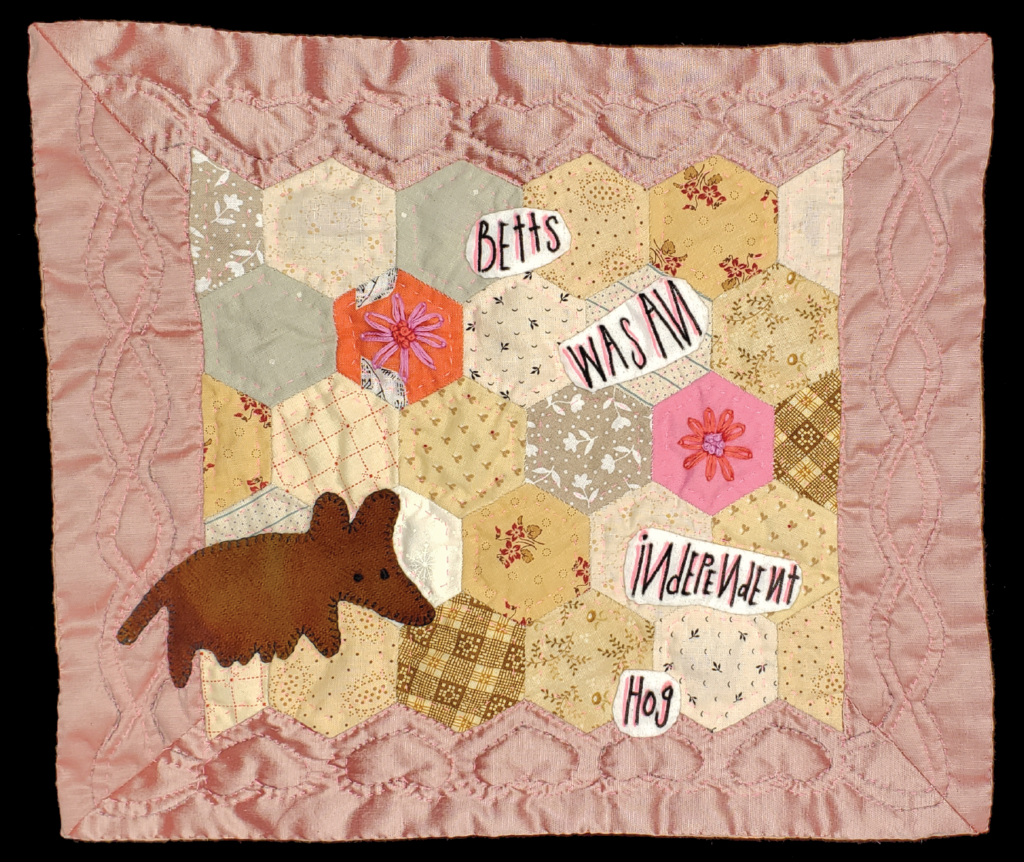
Who Was Harriet Powers?
I made a mini-quilt to honor Harriet Powers. It features a “character” from one of her quilts, named Betts.
So, who on earth is Betts? We’ll get there in a minute. More importantly, who was Harriet? Harriet Powers (1837 – 1911) was a woman, born enslaved, from Athens, Georgia. Little is known about her, although the Museum of Fine Arts in Boston has a photograph of her in their collection.
What she left behind, however, are arguably two of the most well-regarded pictorial quilts known today. The pictorial quilt tradition is significant in African-American quilting communities and Harriet’s two surviving quilts are important early examples of this tradition.
Harriet’s legacy includes the Bible Quilt, an 11-block, appliqued quilt made around 1886, which depicts bible stories from both the Old and New Testaments. The quilt is held by the Smithsonian at the Museum of American History in Washington, D.C. *
Harriet’s other quilt, often referred to as the Pictorial Quilt, is my favorite of the two. It resides at the Museum of Fine Arts in Boston. Made around 1898, and also appliqued, the Pictorial Quilt consists of 15 blocks. Some feature bible stories, while others depict real events of the day. Most interesting is Harriet’s depiction of a meter shower that occurred in 1781 – long before she was born. So we can guess that this must have been a significant event that was shared through generations. Another block references a meteor of 1846; something Harriet may have actually witnessed.
A beloved “character” on the Pictorial Quilt (who is reproduced on my mini-quilt) is Betts, a somewhat ambiguous-looking mammal. She appears in one of the blocks illustrating contemporary, or local, events. A transcription by Jennie Smith describes the block as follows:
Rich people who were taught nothing of God. Bob Johnson and Kate Bell of Virginia. They told their parents to stop the clock at one and tomorrow it would strike one and so it did. This was the signal that they had entered everlasting punishment. The independent hog which ran 500 miles from Georgia to Virginia. Her name was Betts. **
*** Vlach
The reference to Bob Johnson and Kate Bell is cryptic. Perhaps someone has researched and discovered who they are. A cursory database search turned up a Miss Kate Bell in the society pages of several Virginia newspapers, around the time Harriet made the quilt. A Miss Kate Bell is also contemporaneously listed as an assistant in newspaper ads for a girls school in Norfolk.
The story behind Betts also remains a mystery. Maybe there is a diary entry or newspaper mention of Betts out there somewhere. But I do know the approximate distance between Georgia and Virginia is indeed 500 miles. Harriet and Betts inspire me to be creative and independent, and to stay the course, even if the journey is many, many miles!
* The Smithsonian caught some heat when they sold reproductions of the Bible Quilt that were sewn overseas. These quilts can occasionally be found on eBay and other auction sites.
** Vlach’s book (reference in next footnote), which was produced in conjunction with an exhibition at the Cleveland Museum of Art, states Jennie Smith was the transcriber of the narratives associated with each block in both of Harriet’s quilts. I don’t think this is entirely true. Smith was a white woman who purchased the Bible Quilt from Harriet. The Smithsonian states that she gathered the narrative directly from Harriet at the time of sale. However, MFA Boston states the Pictorial Quilt, along with its block descriptions, was a gift to a Presbyterian minister from a group of faculty women at Atlanta University. Its not clear who documented those block descriptions, although the MFA Boston collection entry states the women commissioned the quilt (unlikely in my opinion… but what do I know?). I’m sure there are more definitive details out there.
As a side note, I’ve heard it suggested that Smith may have taken advantage of Harriet in a time of need. Certainly the sale of the Bible Quilt – as well as the Pictorial Quilt – has deprived Harriet’s descendants of any right to them or to be compensated for the use of their image… ahem… Smithsonian. On the other hand, Smith’s privilege is likely the very reason the Bible Quilt was documented and preserved. The church/presentation connection is what likely saved the Pictorial Quilt. There is no doubt both quilts are extremely important pieces of quilt history; or just plain history, period. It’s a double-edged sword for sure.
*** Vlach, John Michael. The Afro-American Traditions in Decorative Arts. Cleveland, Ohio: The Cleveland Museum of Art, 1979.